SEALDs (Students Emergency Action for Liberal Democracy): Research Note on Contemporary Youth Politics in Japan
The Asia-Pacific Journal, Vol. 13, Issue. 37, No. 1, September 14, 2015
David H. Slater, Robin O’Day, Satsuki Uno, Love Kindstrand, Chiharu Takano
A shot from the media area at the front of the demonstration. All images are used with SEALDs permission |
Introduction
Recently, young people have been out on the Tokyo streets and in the mass media in opposition to Prime Minister Abe’s efforts to pass the State Secrecy Acts, the “reinterpretation” of Article 9 of the Constitutions and the Security Bills. None have garnered more interest or exerted more influence than SEALDs, Students Emergency Action for Liberal Democracy. They are worthy of attention for various reasons, but we should note at the start they are the first college-based social movement in 50 years to have drawn such attention in their efforts to directly address the Japanese government’s policy. They are speaking out in favor of constitutional democracy, due process and respect for popular opinion; for peace in Asia and social equality within Japan.
You can see their Facebook page here.
Here is a list of their upcoming actions.
Here is a short promotional video from Facebook
In gaining prominence, they have broken out beyond the historical specter of ANPO, freeing themselves as youth activists from the image (deserved or not) of dangerous and even anti-social radicalism that has contributed to the negative image of all youth activists, effectively undermining similar opposition in the past. Unlike the perceived extremism of ANPO, SEALDs has created a position for themselves as “regular” college students who oppose the extremism of the Abe regime to create a politics that is particularly relevant to young people, a politics that is as distant from the unappealing party politics of the older generation (dasai ojisan) as it is from the dasai (unappealing) and kowaii (threatening) image of radical left political activists (or at least how they have been represented in the mainstream media), they have created a politics that is attuned and relevant to many young people in both content and media form. And in doing so, they have gone far beyond their initial focus as college or youth: SEALDs has given voice to what opinion polls suggest a majority of Japanese find objectionable—the Abe regime’s manipulation of the constitutional system.
Early SEALDs picture of members |
They have learned from and built upon the post 3.11 anti-nuclear movements, expanding its base beyond nuclear issues, while retaining the anti-nuke activists’ support because they have identified a shared root cause: a failure of democratic process by the Abe administration. In ways familiar to other post 3.11 groups, SEALDs has been successful in crafting a social media presence that links up with youth in immediate and flexible ways. Perhaps more significant, they have managed their mass media image on TV and print in ways that allows them to reach a wider audience far beyond tech-savvy youth.
Moreover, unlike so many recent social movements that have withered and died due to lack of sustained support, SEALDs has found a way to forge affective bonds among members that suggest the possibility of a more enduring commitment, even if they decide not to pursue their efforts in their present form. SEALDs in their social media presence, their study sessions and even in their demonstrations, provide some secure place from which normally uninvolved college students can find a political voice, and can find other like-minded students with whom they feel common cause. They have created spaces for young people to emotionally as well as intellectually approach the often unfamiliar world of politics.
A demo poster for T-NS SOWL, a teen group that draws inspiration from SEALDs |
They have also generated a wide range of supporters, parents with children who are concerned about the future of Japan; older people who have seen the dangerous path that Japan is now heading down including earlier generations of activists. Under their encouragement and often direction, other groups have spun off from SEALDs, including the so-called “Middles” (middle-aged, in their 30s and 40s), “Olds” (50s, 60s and older) and even high school groups, as well as a proliferation of initiatives all over Japan from Hokkaido to Okinawa (and perhaps especially in Okinawa) sometimes using the “SEALDs” name to focus their own efforts. Rather than competing with other activist groups, they have sought to build alliances to secure their support, without getting bogged down in the sort of infighting that has plagued so much of Japanese left politics.
They have already overcome a number of obstacles that suggest they are more strategically adept and better organized then other groups. From their previous incarnation as SASPL (Students Against the Secret Protection Law), a single-issue group, or what social movement theorists refer to as a “campaign” (Tilley 1978), they reconstituted themselves in the matter of a few weeks as SEALDs—something most unusual in contemporary social movements in Japan or elsewhere. Today, despite being targeted and harassed by extreme rightist groups, usually internet trolls or “net uyoku” whose work is conducted online, and despite being threatened with job discrimination, they are moving forward. At their demonstration on August 30th, 2015, it was reported that 120,000 participated, even under rainy conditions.
Much of their energy is now focused on upcoming efforts by the Abe government to pass more security bills, and it remains to be seen how these efforts by SEALDs and groups like them have been in mounting demonstrations and gaining media attention to influence policy changes. But regardless of the immediate outcomes, the most significant aspect of SEALDs might not be related to their vocal and articulate opposition to the current administration, but their long-term projects of involving young, middle-aged and older people in a politics of inclusion within an activist civil society—something that is quite new in Japan, at least on this scale.
Just as SEALDs emerged out of SASPL, the current iteration as SEALDs will not, and indeed is not designed to, last forever–only as long as it seems to be the most effective way to reach their goals. Neither the leaders nor members are interested in maintaining a group for the sake of continuity or to secure prominence in the activist landscape: they seek social change. So, with the expectation that they will morph into something else in the coming weeks or months, we present this preliminary research note, drawing on social movement theory, as a way to organize some of the data collected. It is unusual to be able to document a social movement from its very beginning (Staggenborg 2010), and our primary purpose is to outline its origins and convey the potential that it appears to us to possess, even in this early phase; that is, we introduce activist politics in the moment of its creation, and transformation.
 |
| A SEALDs event poster from the point of view of inside the demo |
Research Context
Here at Sophia University, we have been doing volunteer work and fieldwork in the course of our project, Voices from Tohoku, since 2011 (tohokukaranokoe.org) working in Tohoku among survivors, supporters and activists on disaster, reconstruction, and radiation.
Building on our volunteer work and fieldwork research in Tohoku, for the past year, we have followed activist cultures closely as protests have come to a head in Fukushima and Tokyo. From October 2014, we worked with the plaintiffs of a lawsuit over radiation, street activists around the “tent-hiroba” outside of METI (The Ministry of Economy, Trade and Industry), anti-nuke activists at Kantei-mae (in front of the Prime Minister’s Residence) and protests involving mothers who have evacuated from Fukushima to Tokyo. Here is the website—just now getting together: voicesofprotestjapan.org.1
We were already in the field, talking to demonstrators and activists, at the start of the movement then known as SASPL. By April 2015, we had made contacts with the group and secured its permission to begin interviewing, attending organizational meetings and documenting the demonstrations as they reconstituted themselves as SEALDs. Today, they have about 20-25 core members, led by a group of college students who ushered the group through its transition from SASPL. (Full disclosure: some of our researchers are regular members and participants in SEALDs.)
At the outset, we did not expect—indeed no one could have expected—the rise of this group or the power and distinctiveness of their voice within the Japanese activist scene. Even more surprising has been their coverage among the mainstream media. SEALDs is a very new and constantly changing group, one that is developing in their understanding and stance on the issues, in their own approach to addressing them, as well as in their internal structure. They are a smart and serious group of young people committed to making their society better; they are also learning on the job. What we present here is a snapshot of what they have become at the time of writing. (If you are interested in becoming involved in the project, we welcome collaboration from researchers and activists—dhslater@gmail.com.)
SASPL
 | 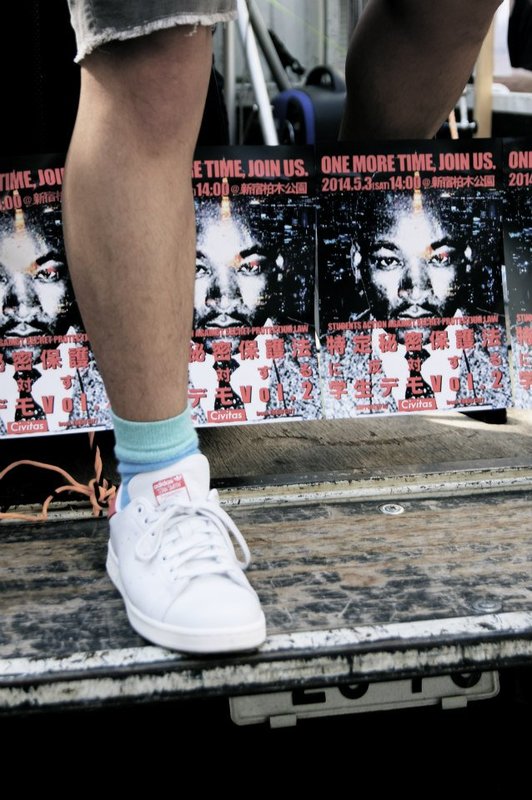 |
| An early SASPL demo poster | A demo poster referencing another struggle |
The original members of SASPL were three college students who happened to gather at one of the protests against the secrecy bills in front of the Prime Minister’s Residence. 奥田愛基(Okuda Aki), with the other leaders 牛田悦正(Ushida Yoshimasa) and 本間信和 (Honma Nobukazu) joining at a later date. It was December 14, 2013 and they had missed their last train home. Huddled together , they recognized the need for a protest group especially for younger people as opposed to the demonstrations dominated by older activists that they had been attending.
Not uncharacteristic of a university-based group, they thought that too many younger people had not studied the issues sufficiently to see them as relevant to their own situation. Not being exposed to serious study of contemporary society and politics in university, their first step was to form study groups. Unlike an earlier generation of activists, there is no evidence of any systematic ideological materials—no Marx or Lenin, Locke or Rand—nor any real review of the history of Japanese political activism, such as the ANPO movement, or Japan’s modern history. Their focus was more contemporary and pragmatic, as they tried to untangle the issues that were in the news at the time, and especially the state secrecy act.
They also wanted to find a way to reach a wider youth demographic. To do this, they focused on a number of key principles that appear to continue to guide their development into SEALDS. In order to engage younger people, they would have to craft a message that communicated in ways that made sense to younger people. Many of the early members felt that then current social movements, including anti-nuke groups, lacked this appeal, either in their media presence—webpages and blogs—or in their style of demonstrations and other organizational activities. They described these movements as dull and dasai, meaning unappealing in their lack of sophistication, but also old-fashioned or out of date. They could see groups that no longer could attract young people to the demonstrations. (Once the younger activists left, the Friday night demonstrations, they were composed of largely older people in their 50s to 70s.) The young activists also seemed to have a broader notion of the “political,” one that saw the potential to have closer connection to the lives of individuals, and they called upon the resources of youth culture to communicate their message in everything from the style of their websites to the ways in which they ran their demonstrations. If their politics were to succeed, it had to be relevant and engaging, had to encompass a fuller notion of the individual, providing a space of sociality and emotional connection for its members. Their first protest was on May 14th, 2015 at a demonstration organized by a federation called Sogakari that drew about 400 people; they participated in three other demonstrations in the next few weeks.2
A demo poster in which SASPL is developing what would become its signature style |
The State Secrecy Act was passed in December 2014. Like other single-issue campaigns that target a particular bill or event, this loss threatened to break the group apart. And indeed, it fell into temporary disarray at this time, with members drifting away and leaders unclear about what to do. But with preternatural insight, certainly for a loosely organized group of college students, the core members had already envisioned the shape of the next iteration of the group. They realized that they would expand the range of their activities and sharpen their focus upon the issues that defined them.
Many members were depressed by the setback. Having little experience with the long haul of any activist effort and unfamiliar with the frustrations of losing, many of members were surprised and daunted at the loss of something to which they had devoted so much energy. Interestingly, in our interviews, some core members made mention of the leaders’ effort at what we might call ‘emotional management’ (Jasper 2009). They urged members to keep an even keel in both their meetings and their public demonstrations from the start. One widely shared slogan was “owattara mata hajimereba ii” (“Even if we lose this one, we’ll start over”). Even today, we see a relatively careful emotional modulation, with one key member explaining that it is their policy not to simply complain or to tell “crying stories” for a sympathetic reaction in the demonstrations or to the media. Democracy, they argued, was the goal of their movement, and while certain events must serve as mobilizing foci, it was also an always unfinished process. Even from the start, they imagined that they were in it for the long-term.
SEALDs
Their new iteration as SEALDs (Students Emergency Action for Liberal Democracy), casts a wider net, addressing issues that include but go beyond the issues of secrecy laws. Here we consider two different ways that SEALDS is setting an agenda: 1. the explicit statements found on their homepage and other documents that cognitively frame the primary issues; 2. their demonstrations, the performative expressions of politics and solidarity, a more emotional framing of these issues.
SEALDs Logo |
Framing Issues, Recruiting Members
In social movement theory, “framing” refers to the ways in which a group identifies and represents issues as relevant its cause. Frames must resonate with the beliefs and orientation of potential members and link these sets of issues to forms of collective actions that define the group. Frames thus provide a “filtered lens” through which members can find clarity and focus on the issues as relevant to their own lives. An effective frame identifies a shared problem faced by members, outlines a set of actions or strategies that might effectively address that problem, and provides motivation to members to join the effort to work together to do so. (See Snow and Benford 1988 for fuller discussion.)
In most social movements, the frames–those explicit statements that allow members to conceptually understand a situation in ways that make it meaningful, relevant and actionable–are the core of any popular activist effort. The more cognitive or ideological frames are usually found in manifestos or other orienting documents. On the other hand, more emotional frames are visceral and immediate appeals that are often found at demonstrations and protest rallies, including the clips posted of the group’s demonstrations on social media. For SEALDs, as with most groups these days, social media play important functions to both cognitively and emotionally frame the issues.
The importance of creating clear and actionable frames are well understood by SEALDs members. For example, when asked about the message behind the movement and what they hope to achieve through their protests, one of member explained it this way.
One thing is that we are trying to raise the issue. We try to let the public know that there is this kind of issue. Issues are socially constructed (社会的に構築されている) so someone has to say that this is an issue in order to make it into an issue…Things become an issue only when somebody points it out. So what we are trying to do through our demonstrations is to create an issue (問題を作り出す).
This is a relatively sophisticated understanding of both the dynamics of issue framing—that they must be constructed by a larger social understanding and awareness—as well as the strategic implications of having to “create” (an even more active understanding than simply ‘defining’) issues by the movement itself.
The issues that define SEALDs are clear and straightforward. (Quotations below are from the SEALDs homepage unless otherwise indicated http://www.sealds.com/, our translation.) Their webpage is clean and direct, accessible to anyone with an internet connection, which is virtually every university student in Japan. It is mostly free of jargon and relies on little more than a cursory familiarity with the contemporary scene in order to understand the political references and context.3 It is unclear how many of the young people at the demonstrations read the webpage or could explain all of the issues, but ample reference is made to these issues at various other occasions, including at the demonstration, at their study sessions and on twitter.
SEALDs demo poster |
Their position begins with the imperative for students to take action to protect a free and democratic Japan. (自由で民主的な日本を守るための、学生による緊急アクションです。) For them, more than for earlier generations, this means protection of the constitution, which they see as being threatened by the current Abe administration. SEALDs has expanded its focus from the dangers of the secrecy act, opposition to which served as the foundation of their earlier iteration at SASPL, to the “reinterpretation” of Article 9 which allows greater engagement of the Japanese self-defense forces, and leads to the security treaties with the US. They see a hollowing out of the principles of democracy and constitutional process due to an over extension and even abuse of state power. The result is a threat to the stability of East Asian society, and a compromise of democratic process and individual freedoms within Japan. One of SEALDs member explained the position of SEALDs on democracy and contemporary threats to it in this way:
The idea of democracy seems like a bright light as opposed to the darkness of fascism (ファシズム) that Abe represents. It’s like we are standing on the bright side in order to wipe away the darkness, so I have this bright image of our message that we are trying to communicate.
The term “fascism, most often rendered in katakana (ファシズム), a common term in their literature and more often in their demonstrations, is used to draw attention to the frightening possible consequence of inaction on the part of the citizenry. The term retains much of the shock-value in Japanese that it has in English, being associated, as one member explained, with ultranationalist, violent opposition to democracy, usually linked anachronistically with Nazism. Indeed, images of Abe as Hitler are common at the demos. In fact, there are participants and even members who might not be sure of the exact meaning or history of the term, but as one member explained, “[We know that it is a] strong term, but basically it is when leaders do not respect the wishes of the people and follow the laws of the country. That is what is happening here” He continued, “Yes, that is pretty frightening, that Abe is like Hitler, at least in this way. It is like a shock [to hear this word], but it should be a shock… People should understand that.”
While protection of the Constitution is the primary safeguard against fascism, SEALDs does not hold the position that the Constitution cannot or even should not necessarily be altered, indeed, they cite the possibility of recognizing sexual minority rights as one desirable change. Rather, they insist that any change be done through the procedures enshrined in the Constitution itself and in a way that reflects popular support. It is only in this way that it is possible to protect individual rights and freedom (個人の自由や権利を尊重する政治を支持します).
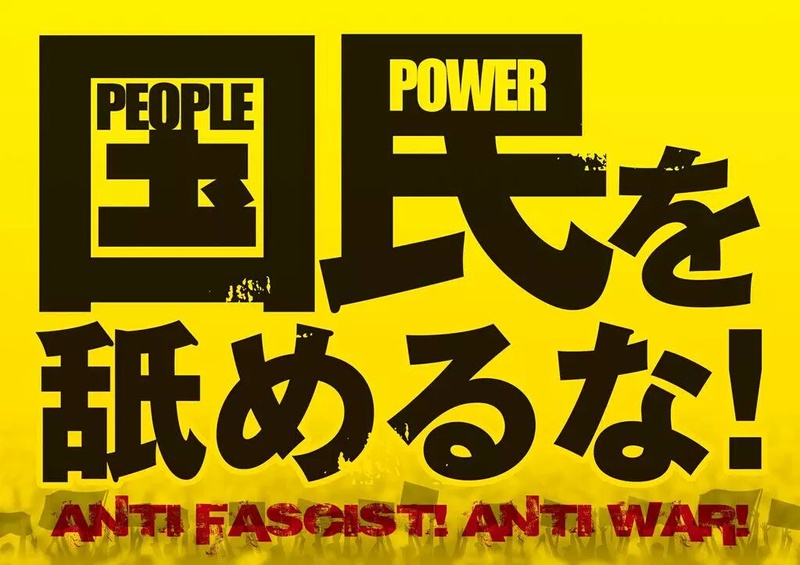 | 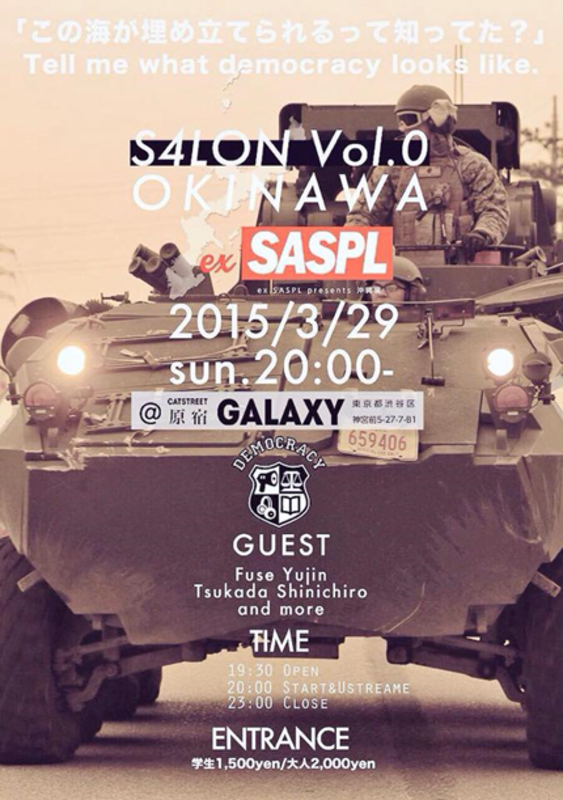 |
| A SEALDs poster appealing to supporters as citizens | A poster for a SASPL meeting in Okinawa |
There are related issues that are featured in their website, including economic inequality and labor reform, in order to improve the conditions of dispatch workers or “working poor;” and a reinforcement of the welfare safety net. They oppose increases in the consumption tax which would weigh most heavily on the poor, and call for greater regulation of companies that practice “black capitalism” (referring to imposition of illegally long working hours, illegal non-payment for overtime, excess performance quotas, and power harassment). There is recognition that these practices not only disproportionately affect disadvantaged groups within the society, such as irregular workers, but also can cripple the principle of fair distribution of wealth and healthy growth of the economy.
The third issue in their platform concerns “national security.” They prioritize peaceful relations especially with Northeast Asian countries based on dialogue and cooperation. (私たちは、対話と協調に基づく平和的な外交・安全保障政策を求めます). The revision of the security treaties with the US, they point out, is a threat to peaceful relationships with other countries, and actions by Japanese state leaders, such as visits to Yasukuni Shrine, exacerbate these relationships. They point out, that as the only country to have been bombed (唯一の被爆国) Japan has a responsibility to pursue nuclear disarmament. The larger historical context of war is alluded to (歴史認識については、当事国と相互の認識を共有することが必要です) but its significance is not specified. In this context, reference is made to “previous sacrifices” to Japanese “aggression” in war but no more details are provided. The webpages close by noting that Japan has a responsibility to promote disarmament and democratization within the region. To address these governmental misdirection and abuse, “liberal” opposition must gather together in order to insure peaceful diplomacy abroad and increase citizen participation within Japan so as to create a new “political culture” (新しい政治文化) .
They cite as contributing factors to this dire situation the LDP’s pushing bills through the Diet without sufficient discussion and ignoring public opinion. They reference forcing Okinawa to accept a new US military base at Henoko as an object lesson of what could happen to Japan as a whole if popular opinion is ignored. SEALDs sees in this perversion of the principles of constitutionalism by the LDP a need to create effective political opposition (現実主義的な政治対抗).
In an effort not to align themselves with any particular political party or side, they are unaffiliated. One SEALDs member articulated the necessity for Japanese people to rethink entrenched political divisions to protect democracy in the following way:
I think “left” and “right” both have their own principles, but I really think that fundamental democracy is imperative and that we definitely should not allow the government to create a law by violating the constitution. So we would like to recruit various people regardless of their political positions.
This is hardly the stuff of revolution. There is no call for any redistribution of income or wealth in a way that challenges the establishment of Japanese corporate capitalism or its predatory neoliberal incarnation. They simply call for more equal wages, poverty reduction and a better safety net. There is no challenging the foundation of the Japanese state or the viability of democratic government, or even a call for overthrow of the LDP regime. They just want the representative government to actually represent the people who vote for them, and to protect the Constitution within the terms that have served as the foundation of the postwar Japanese state.
Anti-Nuke Connections
The success of SEALDs owes debts to the previous efforts by the 3.11 anti-nuke demonstrators. The experience of 3.11 and the anti-nuke movements deeply impressed many SEALDs members. In interviews, most members cite 3.11—the state’s unpreparedness for the tsunami recovery and the mishandling of the nuclear meltdown as well as the subsequent conflicting reports of the danger by the government—as a key turning point in their political awareness (a pattern consistent with other activists interviewed over the past four years). Many mention that the events around 3.11 was the beginning of their awareness that not everything was safe and secure in Japan; that “bad things happen here too,” as one member put it. Participants mention how the myth of safety (anzen shinwa) created a level of critical inspection of the everyday flow of events, and of the state’s involvement, that seemed to be lacking earlier. The second realization that many had was that the Japanese government was unable to handle the situation; that it was either unprepared and/or incompetent to handle it, or in the more extreme variant, the government was not honest with its own people about the danger. The third key realization that came from these two, was that each person needed to take responsibility, to find out the real story themselves, and to act to address a bad situation. Especially through social media, especially young people see this as possible in ways that it was not before.
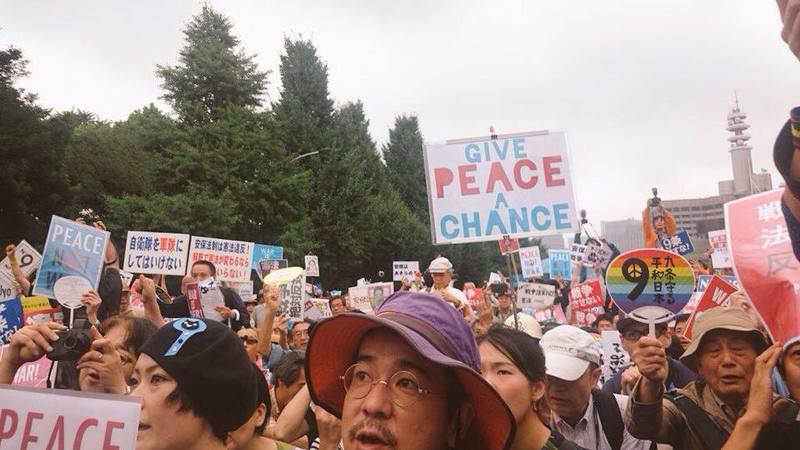 |  |
| A poster showing a full range of ages at a SEALDs demo | A sample of posters designed and supplied by SEALDs that can be downloaded and printed out by anyone at a convenience store |
Many members of SEALDs, and others at the demonstrations, speak of the symbiotic relationship between their own movement and the earlier anti-nuke movements, and in fact, it is easy to see how the anti-nuke movement paved the way for SEALDs. The difference is that SEALDs was able to capitalize on these realizations to establish a broader basis of political engagement that goes far beyond the issues of radiation security and nuclearization.
Staging the Demonstrations
SEALDs holds its demonstrations in the complex of buildings around Kasumigaseki, the center of state power. The anti-nuke demonstrations are in front of the Prime Minister’s Residence while SEALDs and some other groups assemble at the Diet Building. This spatial proximity is important. In the 4+ years since 3.11, from the spectacular demonstrations of September 19th, 2011 to the regular demonstrations each Friday night, have re-established protests as part of the flow of Tokyo life. The range and substance of these weekly anti-nuke demonstrations have done more to normalize street protests and de-stigmatized demonstrators than anything else in the post-war period.
Moreover, the huge range of participants at the anti-nuke demonstrations—from Fukushima farmers to families evacuated from their land to young Tokyo mothers (often with children) worried about food safety to retired people from the pre-accident environmental movement, to union representatives and NPO leaders, and throngs of foreign media, as well as many young people—have opened the way for others, including college students, to appear openly at SEALDs demos. As we have argued elsewhere, radiation and the nuclear power accidents that produce it have proved to be more than a NIMBY issue but rather one that reaches far and wide to many sectors of society. It has not been uncommon for the mass media to identify the main participants at the anti-nuke demonstrations as “regular.” The term (futsuu in Japanese) is usually meant to identify normal people, as opposed to those who are ideologically tainted or extremist in their views—somehow subversive. Even today, many TV reports identity the youth activists in similarly positive ways. This has no doubt contributed to the generally positive coverage that SEALDs has received, and also broken through hesitations among young people about the legitimacy and even legality of protesting.4
An educational poster from SEALDs Kansai
|
Mobilizing for the Demo
How a group mobilized their resources can be indicative of their success. One important resource is generated by the demonstrations themselves. (McAdam, McCarthy and Zald 2004; McCarthy and Zald 1977). Demonstrations can be about a number of things. Some are about the public airing of a political philosophy, or even an exchange and debate about different positions. Others are about sharing personal trauma in a public forum that may herald personal transformation into a member of a group. Other demos, such as freeter demos, are “prefigurative,” and aimed at embodying the sorts of changes they desire.
The SEALDs demonstrations have many different functions, but their repertoire harkens back to an older format of expressing simplified messages shared through a combination of personal stories, strong words by different members (with the occasional inclusion of non-member participants), and call/response chants. Rather than an intellectual exercise or even the passing of information, the primary function of gatherings is the creation of Durkheimian “collective effervescence,” the bringing together of many disparate voices into some emotional focus, to hear each other, and to be heard by society. More recently as SEALDs has garnered more media attention, the function has also shifted somewhat to show Japanese society what it looks like when “regular” young people become politically engaged in common cause around shared values. In the words of one powerful chant, “Tell me what democracy looks like” to which is replied, “This is what democracy looks like,” drawing attention to themselves as they and their actions actually embody the democratic process itself.
The first and perhaps most fundamental achievement of the SEALDs demonstrations is to bring young people to the demonstrations at all. College campuses in the new millennium have rarely been a hotbed of political activism with students known more for their emphasis on school club activities and drinking parties, of taking a well-earned break after the demanding path through high school to get into college and before the next hurdle of the hugely time-consuming job search. Both of these activities, high school cramming and job search, almost require that students position themselves directly in the centers of a society which offers little space for their autonomous voices, and have little use of their creative or critical faculties, let along oppositional efforts. Moreover, these activities are largely isolating, pitting students against each other in a competitive process of invidious comparison rather than finding common cause with fellow students. Thus, the structural expectations mitigate against, rather than provide open possibilities for political reflection and mobilization.
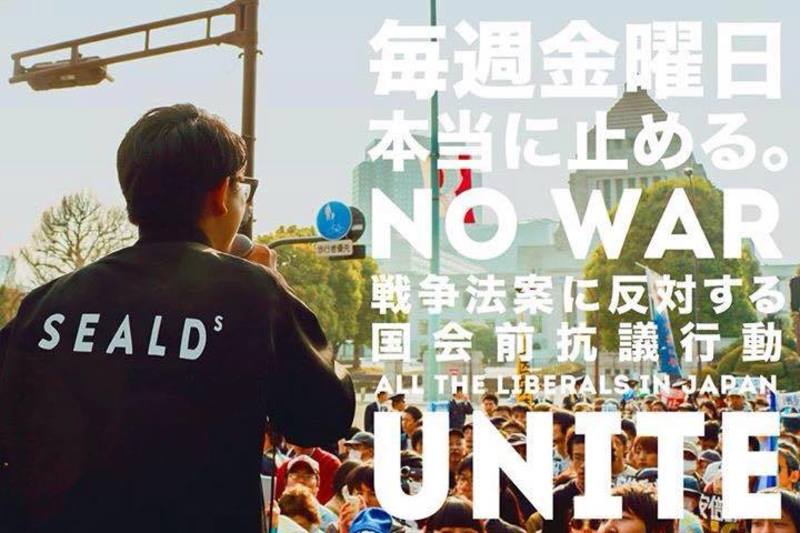 | 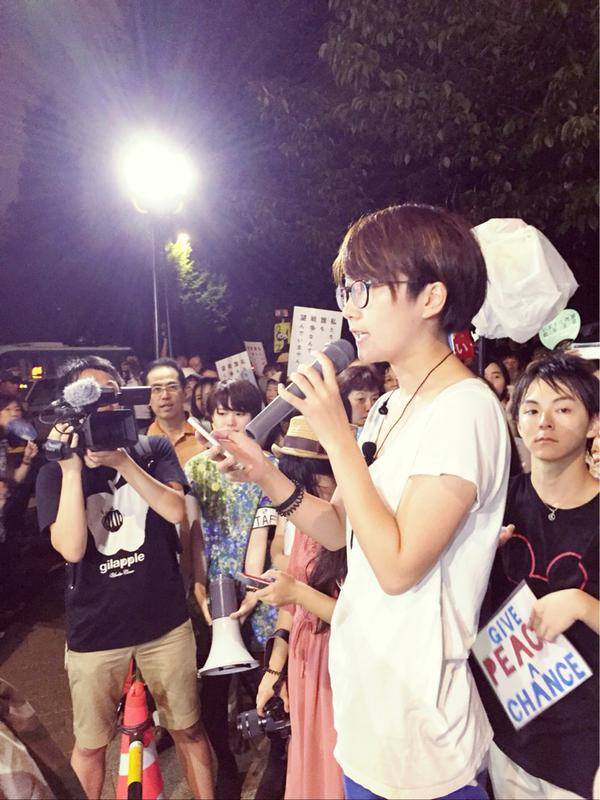 |
| A SEALDs poster for the weekly demo | One of many pictures from Facebook that illustrate “regular” demonstrators |
It is also important to note that we are seeing a very different sort of political dynamic (Tilley 1978) from that characteristic of labor union politics which dominated much of the high growth period in Japan. In a work-based union, potential members already share an immediate everyday work context—and the existence of face-to-face relationships is the single most indicative factor encouraging non-members to join in virtually any social movement (McAdam et al, 2004). That is, people join social movements most often because others they know have already joined. SEALDs, despite being a collection of college students, does not much recruit from their own college campuses. Instead like many other participants in anti-nuke movements, they are more likely to keep their involvement from family, peers and classmates who are not participants. Like the anti-nuke movement, SEALDs face the challenge of recruiting members and mobilizing support through their websites and political events, such as demos, rather than politicizing the institutional connections already existing in the lives, such as school and work. When we asked one core member if they would like to present SEALDs to the class, the response was quick. “No, not at all. I don’t want them to think that I am dangerous or crazy.” While going to demonstrations has become less stigmatized, most young people remain hesitant to share such political interest with others outside of the context of the demonstrations. Members report that everyone has lost friends when it became known that they participated in demonstrations.
Alternatively, if SEALDs has been able to politicize existing relationships, it has been through their personal social networks, their “friends” on Facebook or followers on Twitter, in ways that many volunteer and other anti-nuke groups did over the past 4 years. But even this carries some dangers. Two regular participants in the SEALDs demonstrations explained that they read posts about the demonstrations but they do not repost them themselves. One explained, “social media is very useful, but when you put things on your own [Facebook] page, others might share it; then you cannot really control [who will see it]. This is a bit dangerous.” For individuals who are potentially interested in SEALDs, demonstrations are key moments in the larger campaign because they allow individuals to find others who are similar concerned about and prepared to act on these issues in ways that they feel minimize personal risk. For SEALDs, demonstrations function as important opportunities for recruitment and mobilization.
SEALDs using social media |
Some theorists of social movements suggest that the rise of social media would reduce the significance of demonstrations, in the same way they thought it would reduce the importance of face-to-face interaction in general. Actually, the opposite seems to be the case. As we have argued elsewhere, (Slater, Nishimura and Kindstrand 2012), in a certain ways that are not distinctive to Japan, the rise of social media as the primary means of production, circulation and exchange of information has been accompanied by an increase and shift in the importance of the demonstrations. While social media can connect people who are otherwise often isolated, in term of political mobilization, unaware of the potential of common interests and thus for collective action. SEALDs members are aware of exactly this dynamic. “Learning about politics remotely by social media is useful and important, because you can do it at your own pace, without being pressured by others—you can make up your own mind.” The appearance of overt and strong political sentiment both frightens and repels many college students, and social media provides a sort of safe zone for them.
Nevertheless, the demo, where such sentiment is at its highest pitch, plays an important role in individual political socialization. While social media is important, it has not replaced the need for face-to-face communication; actually, being at the demonstrations represents source necessary, immediate connection. As one core member explains, being at the demonstration engages you in different ways. Being there engages your “five senses” in visceral and immediate ways that are not possible through social media. You can actually “see” how people “feel” about these issues, in ways that create “unity of feeling” (danketsukan団結感)that is not possible online. Both music and chanting, the rhythmic aspects of demos, the moving of bodies and the hearing of voices, including your own, in real time, is a sensory experience that gives reality to the abstract knowledge that is disseminated by social media. It is a different way of knowing. Collins (1990) explains, emotions are not just something that accompanies politics, but “are the ‘glue’ of solidarity—what mobilizes conflict,” and what makes politics both immediately felt and commitment enduring. Being together, “in real time and real place,” as one participant explains, is necessary to this sort of emotional management, one key to mobilization.
A placard featuring Abe’s image |
Abe as Political Opportunity
While preventing the restarts of the nuclear plants provided an initial focus for the anti-nuclear movements, the delayed and partial opening of the reactors has allowed Abe, and those before him, to effectively dissipate much of the feelings of emergency from the anti-nuke movement. More than one anti-nuclear activist have expressed frustrations at so many of her fellow activists “feelings of resignation” over the inevitability of re-establishment of the nuclear program, with few changes made to improve regulation or to provide a structure of checking for violations. SEALDs, on the other hand, has benefited from Abe’s activist approach on a series of contentious issues, especially the “reinterpretation” of Article 9 and the security treaty that allowed Abe, and thus SEALDs, to keep its platform in the news. That is, Abe’s actions, and the unease they produced within the public, constituted what social movement theorists call a “political opportunity,” events in the surrounding political landscape that offers a chance for different actors or groups to exploit for political gain (Tarrow 1994). One older activist explained how this has benefited SEALDs: “today, when it appears that there might be a waning of attention [for the positions SEALDs hold], Abe does something else that surprises even seasoned activists,” and shocks other less experienced members who are just starting to pay attention to politics. “SEALDs has used that very effectively.” One of the leaders recognizes the strategic aspect of this moment when he explains that while Japan is in a horrible position, having to struggle for such basic rights as peace and representation, something good has also come of it when one considers how many young people are finally thinking about politics.
The secrecy acts, the “reinterpretation” of article 9 and the security treaties are not hugely complicated—not as complicated as TPP, for example, where even many of the farmers we have interviewed are not quite clear what it is in it. The fact that there have been few clear statements by the Abe administration attempting to clarify or meaningful and productive debate in the Diet, only makes the details and possible implications all the more obscure. There is a mainstream media pattern in TV and print that promotes the state’s efforts as a way to facilitate the positive role that Japanese self-defense forces can help other countries’ efforts to make peace around the world. One colleague, citing an NHK special that focused on SDF abroad in a war situation, explained that the real need of these bills is to facilitate Japanese troops’ role in humanitarian efforts, such as in Cambodia to remove land mines. She explained that under the current strict constitutional rules, the SDF is unreasonably shackled, for example, from being able to help airlift the victims of these mines even when they were the only force equipped and capable of such life-saving activities. In social movement terms, this illustrates the Abe administration’s successful framing of the issue by its supporters. At the demonstrations, SEALDs reframes these issues in relatively stark terms, not as an effort to contribute to collaborative peace-keeping missions, but as a first step to war.
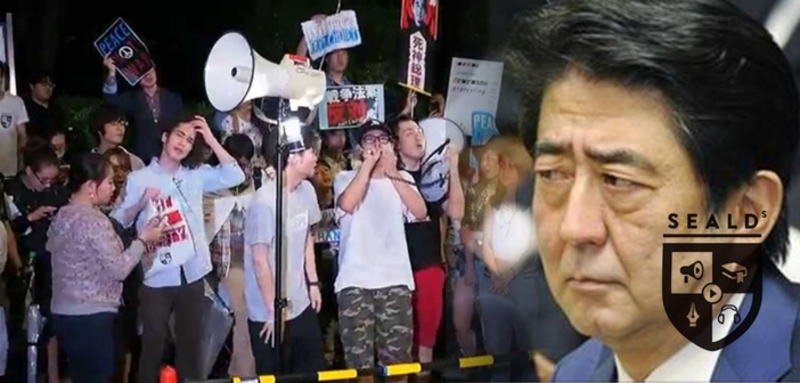 |  |
| A mashup with Abe looking askance at SEALDs | One of the iconic posters of the movement |
WAR IS OVER
In order to identify some immediate threat–something that would constitute an “emergency” (the “e” in SEALDs), and a strong motive to act now, SEALDs has identified perhaps the most immediate threat–war. The SEALDs approach to this issue is a very direct frame, more emotional than cognitive. “NO WAR” or “WAR IS OVER.” One chant is more immediate: “I won’t kill anyone” (誰も殺すな).They argue, to the extent that this reinterpretation allows it and the new security treaties direct it, war has now been legitimated for Japan. They do not speak of wars of aggression vs. defensive wars, a war to protect oil interests vs. a war to protect Japanese lives, just vs. unjust wars, forced conscription vs. voluntary enlistment, etc. This is not to say that these distinctions are unimportant, but theirs is a simple and direct appeal, less a simplification than a clear identification of one of the many different consequences of this shift. This is easy to understand and easy to take a stand on. This possibility is one that is often brushed aside by many in the Abe administration, but has rarely been categorically denied. In fact, “NO WAR” is most often linked with “if you want it,” (echoing the phrase’s use by John Lennon and Yoko Ono two generations ago—a debt that is not generally acknowledged, but nonetheless powerful). As such SEALDs also frames the absence of war as a choice of citizens. And who would choose war, especially the fighting of a war for American geopolitical ambitions or fascist or racist ambitions—two other themes brought up at the demonstrations than in print? This frame suggests that personal commitment can make a change in the world. These are, to many if not most of the participants, a new, empowering and even exciting possibility.
Re-representation of SEALDs events linking to social media |
Most of the chants are similarly direct
Kenpou Mamore! Protect the Constitution
Kodomo wo mamore! Protect Children
Mirai wo mamore! Protect the Future
Jiyuu wo mamore! Protect Freedom
Inochi wo mamore! Protect the Land
Abe wa yamero! Let’s get rid of Abe
Sensou Hantai! Against War
Fashisuto (Fascist) toosuna! Let’s not allow fascism
Dokusai yamero! Let’s get rid of the dictator
Daremo korosuna! I’m not going to kill anyone
Longer chants:
Sensou Houan zettai hantai! Completely Against the War Bill
Kaishaku Kaiken zettai hantai! Completely Against Constitutional Revision
Abe Shinzo kara Nihon wo mamore! Protect Japan from Abe Shinzo
Abe Shinzo kara kenpou mamore! Protect the Constitution from Abe Shinzo
Abe Shinzo kara Heiwa wo mamore! Protect the Peace from Abe Shinzo
Abe Shinzo kara kodomo wo mamore! Protect the Children from Abe Shinzo
Abe Shinzo wa ima sugu yamero! Let’s dump Abe Shinzo right now
Rhythmic calls:
I say ‘kokumin’, you say ‘namenna!’ Kokumin! Namenna! x3
I say ‘kenpou’ You say ‘mamore! Kenpou! Mamore! x3
I say ‘Abe’! You say ‘Yamero!’ Abe! Yamero! x3
I say ‘sensou’ You say ‘hantai’! Sensou! Hantai! x3
Tell me what democracy looks like! This is what democracy looks like!
Minnshu-shugi tte nannda? (Nannda?) Minnshu-shugi wa koreda! (koreda!)
In most social media theorizing we have outlined above, effective movement frames require some relatively immediate negative consequence—in this case, the possibility of war. So too is it necessary to have some common enemy, someone against whom the “us” can be formed as a coherent and potent social actor in this newly defined political landscape. While the self-evident candidate at present is the Prime Minister, the way SEALDs uses him is more sophisticated than it at first appears. Placards that name Abe are all around every demonstrations. “ABE Sori Yamero”–Let’s put an end to Abe—is the most common refrain in the chants, the moment when the attention and rhythm of the crowd becomes refocused (after the somewhat more ragged chanting when the lines become longer, more complicated and often syncopated in ways unfamiliar especially to older participants). There is even at least one costume with Abe a Hitler who shows up at different demos. Of all of the chants, none are as common as those that identify Abe by name.
This personalization provides a vehicle for the emotional expression most often associated with social movement protests—indignant outrage. Explained one older environmental activist, “The mention of Abe is very effective. They [younger protests] really seem to like to hate the Prime Minister, as an individual. This is something that was not so common in the anti-nuke demonstrations,” and she later thought, maybe one of the real strengths in the SEALDs demos. Anger and rage are most effectively focused on concrete rather than abstract system (eg neoliberal capitalism) or even policy (eg. TPP); a target in a person is best.
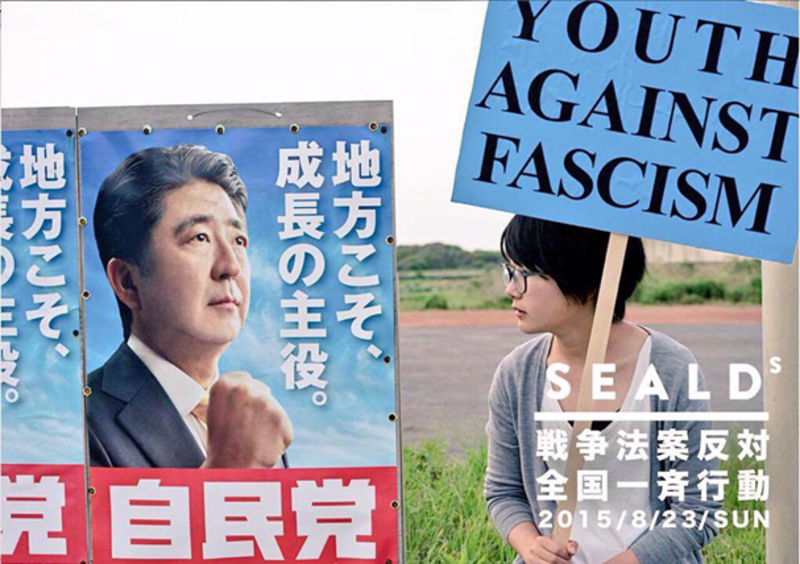 | 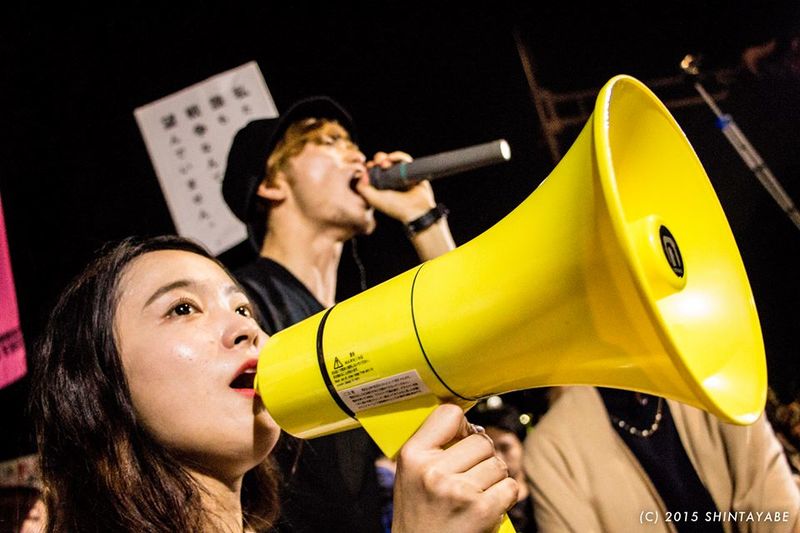 |
| Personalization of Abe as emotional focus, with humor | Coordinated call and response |
The effects of such personalization around Abe are many and different to different audiences. One thing that many of the younger participants at the rally told us is that to hear college students speak like this, out loud and directly to address the Prime Minister, for others to hear in public is both emboldening and exciting. In fact, many participants were initially opposed to identifying anyone by name, least of all the Prime Minister. Explained one college woman from Saitama, “At first I felt self-conscious or ashamed (hazukashii covers this semantic range) to speak so harshly. But I don’t anymore. I think it is fine to speak like this, if you are against something, and if you feel strongly about it.” An older person at the demonstration explained, “I don’t know much about this group, but it is amazing to hear young people feeling so strongly about anything. To hear them speak so strongly, to care so much. That is surprising—great, but surprising, also.” Clearly, part of this rhetoric’s force comes from its shock value –the image especially of pretty young college women cursing Abe in public is not an everyday occurrence in polite Japanese society, and doubtless is one factor explaining media coverage of the demonstrations.
This relatively extreme chant about Abe, that is, calling Abe a fascist, opens up space for participants to emotionally fill. After one demonstrator led a chant she explained, “Sometimes you need to do something first, and by doing it, you come to understand it.” Asking the chanting college student if she felt so strongly as to use such chants, she responded, “At first I did not, and I guess that is why I felt strange about it. But I have done more research, I’ve found out more about the issues, and I have talked to other people here and listened to the SEALDs members talk at both salons and at the demos. These are really important things and now I do feel strongly… I guess that is why I can say that even though I know it is a bit much, I can feel it.” In this case, the emotional tenor of the demonstrations allows individuals to find some sort of affective coordination, another way to immediately and emotionally situate themselves in relation to the issues. Goodwin (1997) adapts Freud’s use of the term calls this a ‘libidinal economy” in which members can participate in ways that facilitate the reciprocal affective exchange that links members to each other and to shared issues.
But it is also part of the collective force of this, or any demonstration. One Japanese organizer explained, “Japanese are emotionally dead. My job is to wake them up, make them feel something, maybe anything…. The coordination of chants allows many of us to speak as one,” an externalization and concretization of felt but not fully articulated anxiety and fear, reformulated as anger and righteous indignation—emotions that are more clearly operationalized within the context of collective social movements. Thus, the performative aspects of this sort of talk is both transformative of individuals–providing some emotional path for them to develop the sort of anger, or righteous indignation, but emotions also drive ideas (Jasper 2009), and tethers ideas to people, and people to each other. It creates the sort of boundaries, the “us” that is at the foundation of some shared movement identity, and supplied resources for the development of a distinctive movement culture; a set of ideas that allows a group to coalesce around a shared set of commitments–both cognitive and emotional–to these ideas.
Another participant, also attending a demonstration for the first time in her life, identified another effect. “I guess these words and the chants are strong words, but that is how these young people feel, so I guess it is ok to speak like this.” She explained, “this is how other people, the people who are just watching and also the social media, know that people are serious.” Thus, with the knowledge that all demonstrations are for multiple parties—core members, non-member participants, watching audience at the event and media (both mass and social) audiences, the demonstration of emotions for others can be as important as the role emotion plays in creating solidarity among participants with the goals and individuals of the movement.
Some of the most public female leaders of SEALDs |
The demonstrations themselves are staged so that young people are front and center, forming the core of the chanters and speech-makers, even when the vast majority of those assembled in the SEALDs’ section are older, from all walks of life. In the words of one activist, “This is what the movement looks like—the young SEALDs members are out front, and we are supporting them. They are getting the attention, which is great, but we are here, too, which is important.” This works as powerful political theatre for the phalanx of media assembled. The image is of a wave of fresh-faced young people, “regular” in appearance with the stylish street-inflected fashion that defines most college students today. The discordant image of this picture is the open and sometimes raw emotional performances, hip hop style, females in equal numbers to males, taking the mic in leading chants and mixes. This juxtaposing of “regular” kids with the harsh, direct and focused emotions they express is probably, as much as anything else, is one reason that other activist groups report that they began to take SEALDs seriously. Some of the turns at the mic are personal narratives of political awakening or short history lessons on Japanese politics, and many are delivered in syncopated rhyme and call-response formats. Unlike some other post-3.11 groups, they do not give the audience or the camera overly emotional individual hardship stories or personal remorse. Instead, what we hear are often emotional outbursts of anger and indignation, over the shape of politics in Japan today, and about the possible futures that this path could lead to. A common refrain is the questioning of the audience—“Is this what you want?” with much of the ire directed at Abe’s role in today’s Japan.
In fact, females frequently take center stage in many of events, especially in the more performative parts such as chant leading and rapping, which have been in Japan as elsewhere male performative moments. Females do not usually project the volume of the males, but some rap even in the more aggressive styles, while others goof around a bit, turning the call and response into an idol parody. This displays a certain level of perceived trust of the females that is absent at many groups’ demonstrations. Some people call these women the real face of SEALDs; others call them celebrities of the movement; still others say they are eye candy. The male core leaders, lacking the photogenic polish and flair, are more likely to give explanations of history or policy at the demonstrations, and they are more often interviewed by the mass media, asked to explain the movement, but get into the print and TV media less often. A number of women in the movement have said that the male core members make it a point to delegate responsibility to females as they would to any skilled performer. One women called this part of the “feminism” of SEALDs. This gendered division of political labor is not something that is strictly planned and of course fluctuates based on the particular participants and their performative skills. In any case, the prominent role that females have in both the public face and backstage organization of SEALDs stand in sharp contrast to most social movements, certainly in Japan. And just as importantly but less obvious at the demonstrations, much of the important interfacing with authorities—gaining permits, negotiating with police, etc.—is also done by women, although departure from many other social movements.
An unusual series of sequential demos, a very successful strategy for recruitment |
Systemic Critique vs. Cross-Movement Networks
Some older activists we’ve talked to are more critical, even dismissive, of SEALDs. One retired activist in his early 70’s explained that there was no reason to be so emotional. “That sort of emotionalism only makes them look young and stupid. It does not have any real meaning in itself.” He added, “It also marks them as extreme, and that is the end [of their success as a social movement]…. [If that happens], then no one will talk to them.” He pointed out the ridiculousness of comparing Abe to Hitler, someone who killed millions of people. “They look naïve.” An older activist who identified herself as both a feminist and environmentalist was first admiring. “That sort of passion and fire. They are great. I remember that [from my own younger activist days].” But she also said that the focus on Abe was misplaced. “It is not about Abe–it was like this way before Abe. They are young so they do not know, but it is a system, not a person–that is the real problem.”
The personalization of protest against Abe could run the risk of mistaking the symptom for the cause, or at least the forest for the trees. While is it certainly true that Abe has personally pushed forward a number of reforms that even former Prime Minister Nakasone was not able to advance, and he has managed the Diet in ways that are uncharacteristic of any Prime Minister, his views are not isolated and uncharacteristic of many powerful politicians in key positions in Japan today. Moreover, his ability to pass his agenda is an immediate result of the substantial numbers in the Diet that the LDP-led coalition enjoys as a result of elections held after his agenda was clear enough for anyone paying attention to discern. Some experienced activists thus argue that to personalize the demon in Abe distracts from the larger, systemic considerations.
But this focus on Abe personally also has two other effects that are productive for SEALDs. The first is that it makes these issues easy to understand in a cognitive way, and like the emphasis on war, it allows wide numbers of people to make an emotional investment, as noted above. This is not to say that they have failed to frame the larger and systemic issues involved—and indeed, some of these structural considerations are outline in the web and print materials—but at the demonstration at least, it is important to provide some way for those present to be emotionally invested; Abe becomes that focus of that investment.
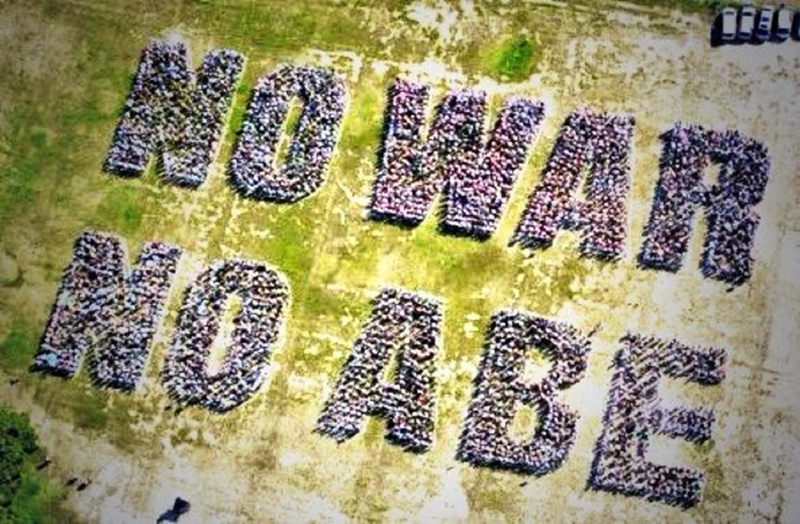 |  |
| Image retweeted onto the SEALDs Twitter account from a Hiroshima demo | Mothers Against War, one of many groups that participate in SEALDs demos |
The personalization of Abe also serves as a bridge between SEALDs and other activist groups with diverse agendas, especially those in the post-3.11 period. In the words of one peripheral member of SEALDs, “Everyone hates Abe; it is something we have in common–with anti-nuclear people, the more radical scary [extreme activists], and even the moms. They all agree with us on that.” If not the violations of constitutional practice, then the pushing through of multiple actions with apparent disregard of public opinion is something that is as strongly felt by many groups. In this case, the person of Abe stands as a placeholder for the violation of process, the heart of a wide range of groups’ grievances.
That said, the sorts of connections with other groups and SEALDs are not institutionalized connection in the form of group-to-group affiliations. In fact, SEALDs holds no affiliation with any other group and has been quite scrupulous about avoiding such connections, even while maintaining good informal relations with most other groups. They have no connections to the Communist or Socialist parties, as was the case with ANPO groups. On June 27th, 2015, SEALDs organized a speaking event at Shibuya’s Hachiko of different opposition leaders, including former Prime Minister Kan Naoto, Japanese Communist Party president Shii Kazuo and even Hatsushika Akihiro, parliamentarian for the conservative Japan Restoration Party. More than 7000 people attended to hear these politicians and students speak in protest against Prime Minister Abe’s security policies. The goal was dialogue in opposition, rather than endorsement of any group or position, or the promotion of a unified agenda. There are no connections to labor groups or to any of the anti-nuclear groups, although both groups will show up at SEALDs demonstrations in support of them and informally, SEALDs has received support and advice from some of them. There are not even connections to other youth activist groups such as Zengakuren (All-Japan League of Student Self-Government). Part of the strategy of SEALDs is to carve out an unaffiliated place that is not associated with any particular ideological commitment, history or position, thereby avoiding the sectarian bickering that has crippled the Japanese left in the post war period.
Three oppositional leaders shaking hands at a SEALDS demo |
Speaking from the Center
Finally, the personalization of Abe by SEALDs makes possible a critique of current policy and practice while avoiding the indictment of the system of government as a whole. That is, the use of “Abe” at the demonstration is a metonymic usage where the person stands not for the whole government, but only for a more specific set of abuses. Concomitantly, this allows SEALDs to position themselves less as a radical group critiquing the Japanese state or corporate capital, and instead as a more mainstream voice critiquing a radical departure (Abe’s) from what has become accepted as common sense in postwar society.
Thus, SEALDs is unlike previous groups, from ANPO to Freeter Unions, that have been characterized as extreme responses that often fly in the face of shared political sensibility and even everyday life. SEALDs seems to be portraying itself as a common-sense response to an extreme political situation, a political situation that has gone against the common sense of post-war political arrangements. As polls show, a majority of citizens, even across a variety of positions on constitutional revision or security treaties have been opposed to Abe’s pushing these reforms through. In this sense, SEALDs is more of a restoration than a revolution, restoring the principles of democratic process, representative government and pacifism. If calls for respect for the Constitution or pacifism are minority or extreme positions, as they are sometimes represented to be, it should tell us more about how far to the extreme right the Abe administration has pulled Japan, rather than how extreme the stance of these young people might be.
So far, SEALDs has done a good job of framing these issues and communicating them to a public that seems to share many of its views but does not know yet how to articulate them as effectively. Note that right now there is no war to be against, and the real threat lies obscure and mystified political process of the bill’s passage—not something most people in Japan or elsewhere get too concerned about, if they can even bother to follow it at all. And yet, SEALDs has been able to bring to attention the immediacy of this situation. In the words of one older activist, spoken with begrudging admiration, “It is not easy to generate opposition to a war that does not yet exist; being against war as an idea or against some future possibility of war does not carry the same force. Yet, this is just what SEALDs has done, and more effectively than other groups today.”
The immediate challenge of SEALDs looms before it as the Abe administration seeks to push through the next set of security bills. Almost all attention is focused on blocking these efforts. While it remains to be seen how much street demonstrations and sympathetic media coverage will sway such events, the growing prominence that SEALDs has enjoyed certainly takes a toll on the group itself. It could be that they will decide that morphing into another form—not unlike their transition from SASPL to SEALDS—will be the best way to bring about the changes they are seeking. They are more committed to a bringing about change that they are to push their group per se. So, it is hardly surprising that much of what SEALDs does is less obvious and directed at more grassroots efforts to educate students and young people more generally about these issues, to get them interested in politics and show them how to get involved. Regardless of the success or failure of the Abe administration in the next few weeks, these efforts by SEALDs might be the more significant contribution by SEALDs in the long run. We will review these efforts in a subsequent article.
Related articles
• Robin O’Day, Differentiating SEALDs from Freeters, and Precariats: the politics of youth movements in contemporary Japan
• Scott North, Limited Regular Employment and the Reform of Japan’s Division of Labor
• Noriko Manabe, Music in Japanese Antinuclear Demonstrations: The Evolution of a Contentious Performance Model
• Noriko Manabe, Uprising: Music, youth, and protest against the policies of the Abe Shinzō government
• Nicola Liscutin, Indignez-Vous! ‘Fukushima,’ New Media and Anti-Nuclear Activism in Japan
• Sachie Mizohata, The Trans-Pacific Partnership and its Critics: An introduction and a petition
• David H. Slater, The Making of Japan’s New Working Class: “Freeters” and the Progression From Middle School to the Labor Market
• Emilie Guyonnet, Young Japanese Temporary Workers Create Their Own Unions
• Stephanie Assmann and Sebastian Maslow, Dispatched and Displaced: Rethinking Employment and Welfare Protection in Japan
David H. Slater is professor of Cultural Anthropology and Japanese Studies at Sophia University.
Robin O’Day is a cultural anthropologist, and currently a Japan Society for the Promotion of Science (JSPS) post-doctoral fellow at the University of Tsukuba. He is an ethnographer who works on labor and youth politics.
Satsuki Uno is a graduate student in the IT-Asia program at Tokyo University. She works on urban space, youth culture and social media.
Love Kindstrand is a PhD student in the Department of Anthropology at the University of Chicago. He studies emerging expressions of political subjectivity and struggles for representational space in Tokyo and Japan.
Chiharu Takano is an undergraduate in the Faculty of Liberal Arts at Sophia University, researcher and activist.
Recommended citation: David Slater, Robin O’Day, Satsuki Uno, Love Kindstrand and Chiharu Takano, “SEALDs (Students Emergency Action for Liberal Democracy): Research Note on Contemporary Youth Politics in Japan”, The Asia-Pacific Journal, Vol. 13, Issue 37, No. 1, September 14, 2015.
Sources
Benford, R.D., and Snow, D.A. (2000)
“Framing processes and social movements: An overview and assessment.” Annual Review of Sociology 26, 611–639.
Collins, Randal (1990)
“Stratification, emotional energy, and the transient emotions.” Research agendas
in the sociology of emotions, 27-57.
Goodwin, Jeff. (1997)
“The Libidinal Constitution of a High-Risk Social Movement: Affectual Ties and
Solidarity in the Huk Rebellion, 1946 to 1954” American Sociological Review
Vol. 62, No. 1 (Feb., 1997), 53-69
Jasper, James (2009)
The Social Movements Reader: Cases and Concepts 2nd Edition. New York, Wiley-Blackwell.
McAdam, Doug; John D. McCarthy; and Mayer N. Zald (eds.). (2004)
Comparative Perspectives on Social Movements: Political Opportunities,
Mobilizing Structures, and Cultural Framings. Cambridge: Cambridge University
Press.
McCarthy, John D. and Mayer N. Zald. (1977)
Resource Mobilization and Social Movements: A Partial Theory. American
Journal of Sociology 82(6): 1212-1241.
Slater, David H., Nishimura Keiko, and Love Kindstrand, “Social Media, Information,
and Political Activism in Japan’s 3.11 Crisis,” The Asia-Pacific Journal, Vol 10,
Issue 24, No 1, June 11, 2012.
Staggenboard, Suzanne (2010)
Social Movements, New York, Oxford University Press
Tarrow, Sidney. (1994)
Power in Movement: Social Movements, Collective Action and Politics.
Cambridge: Cambridge University Press.
Tilly, Charles. (1978)
From Mobilization to Revolution. Massachusetts: Addison-Wesley.
Notes
1 The project is linked to the Faculty of Liberal Arts and the Graduate School of Japanese Studies at Sophia University, and funded by a Kaken B grant from the Japanese Government. Our research team consists of undergraduate, graduate and post-graduate students working together in subproject groups. Document and archival work supports the video interview and ethnographic data that is the core of the project. Data is shared among groups and members with all contributors being able to draw upon the data for collaborative or individual research and writing. The data collected—video interviews, transcripts and translations, etc.–are shared with members of NPOs or social movement groups for their own purposes. The project is open to all and welcome collaboration from researchers and activists.
2 For an interview with some of SASPL members see here.
3 This was confirmed in an interview by one of the authors during a demonstration when a college student explained his appreciation of the fact that he could “understand what [SEALDs] is talking about even though I don’t read the newspaper.”)
4 In 2012 after David Slater informed his undergraduate students about the demonstrations and encouraged them to check them out for themselves, one well-meaning student came up to me after class and said, “Maybe this is not true in America, Professor, but here in Japan it is against the law to demonstrate in the street.” I explained that it was not against the law, at least not YET, but if no one exercises their rights to demonstrate, it might be soon. Today, at least in my college, almost no students still think like this, despite repeated efforts by police at many of the demonstrations that warn participants that assembling on the streets causes trouble to others.
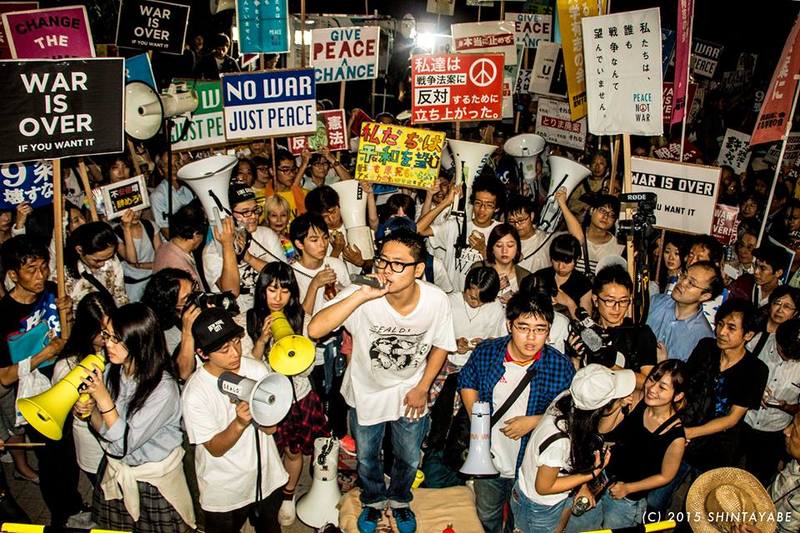
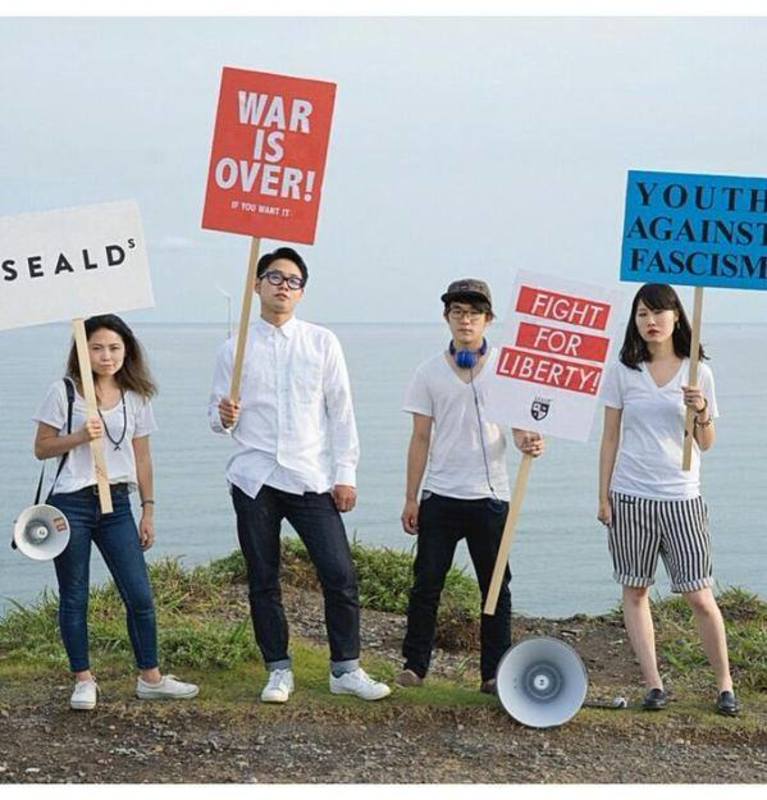
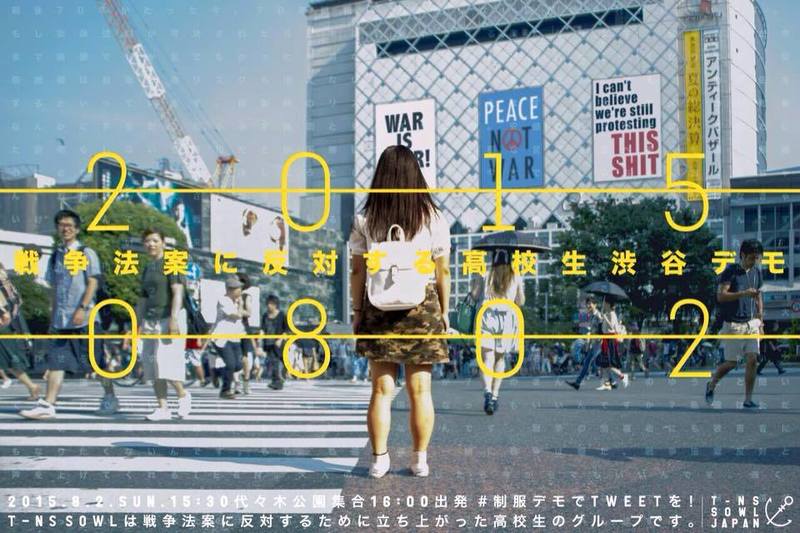


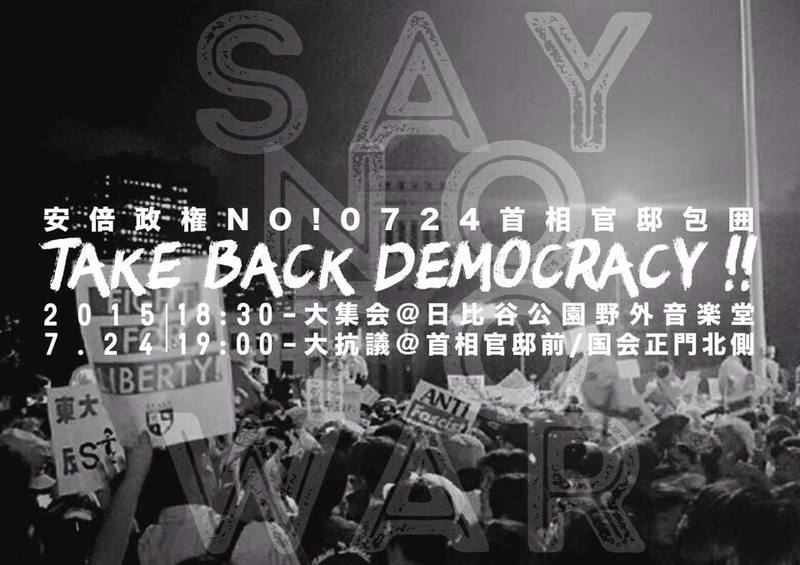
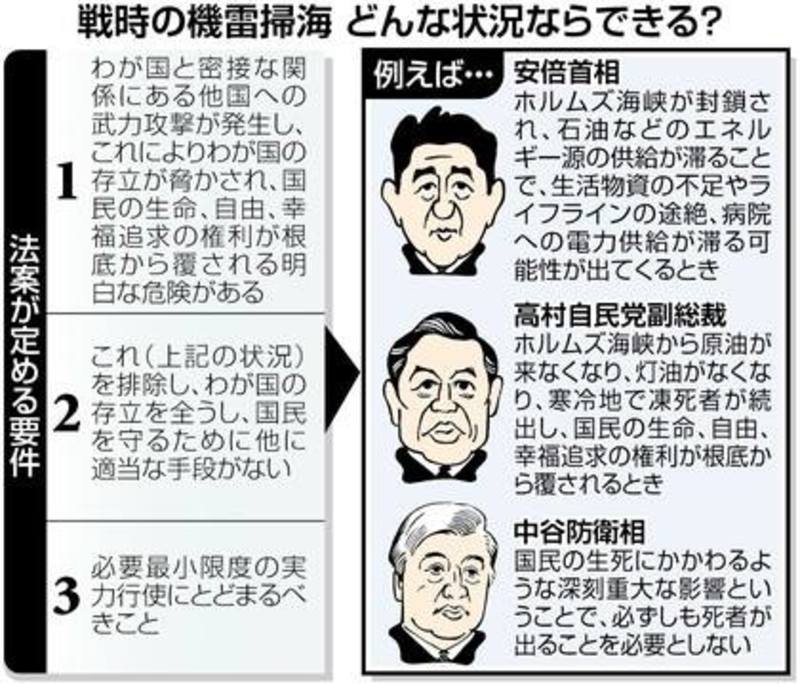
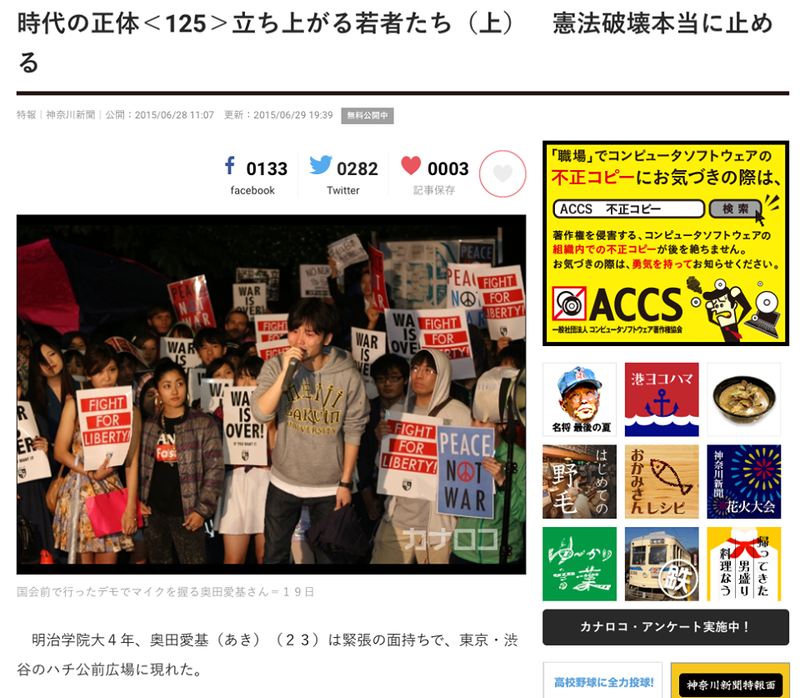
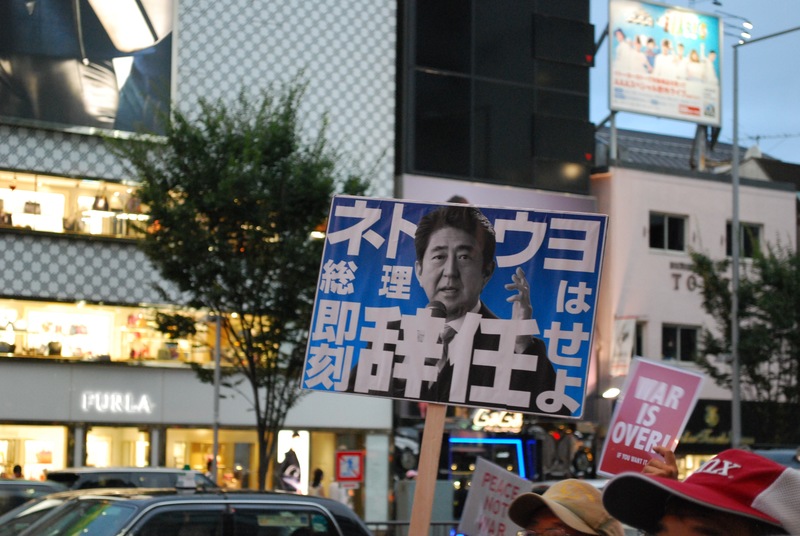

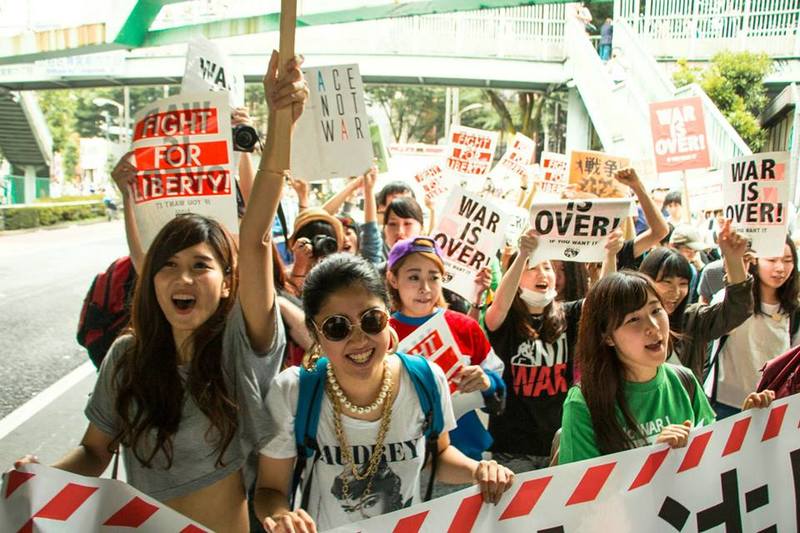
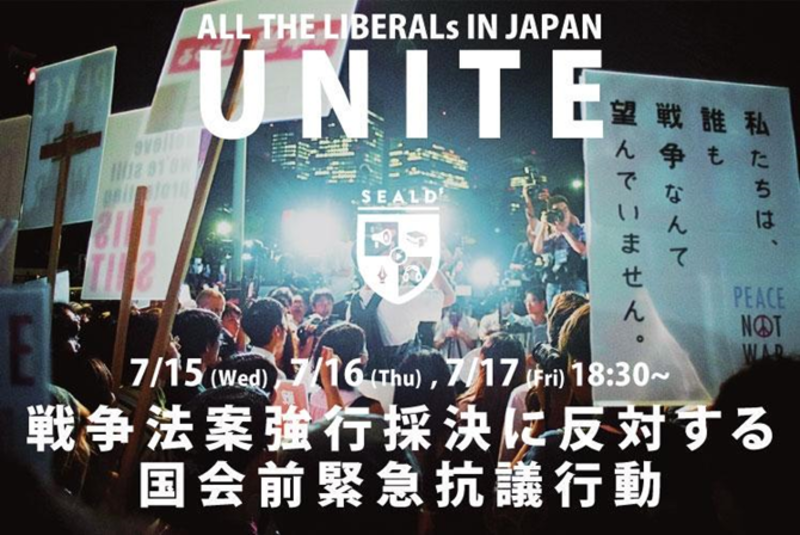
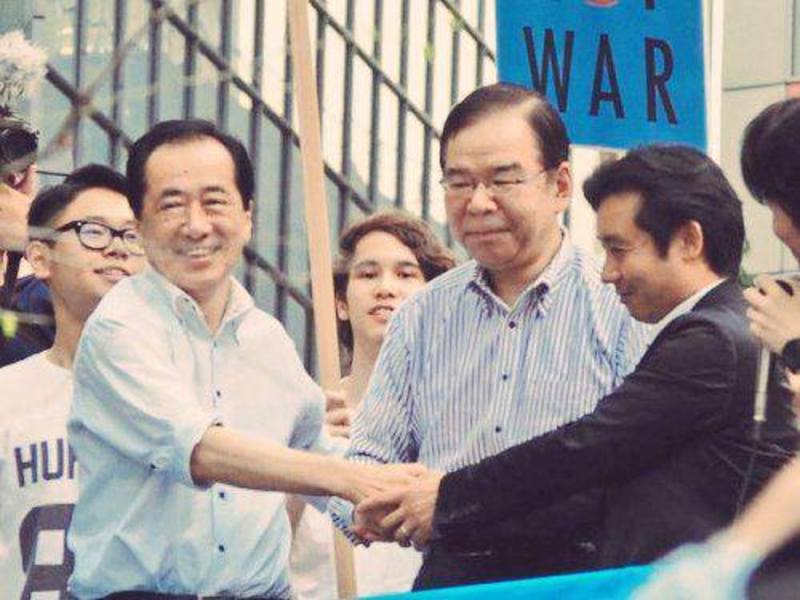
Leave a Reply
You must be logged in to post a comment.